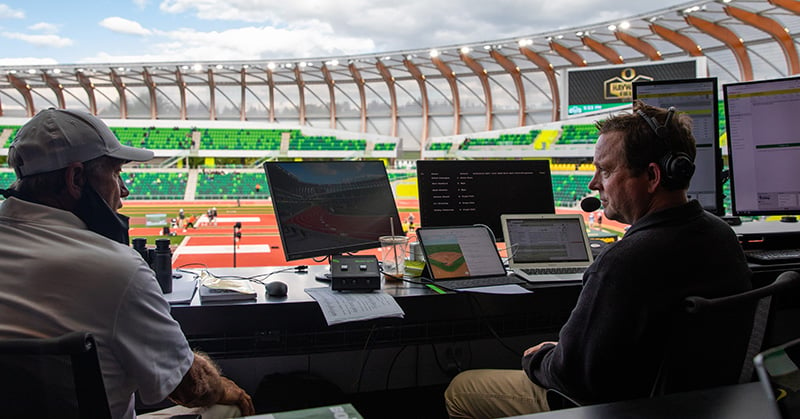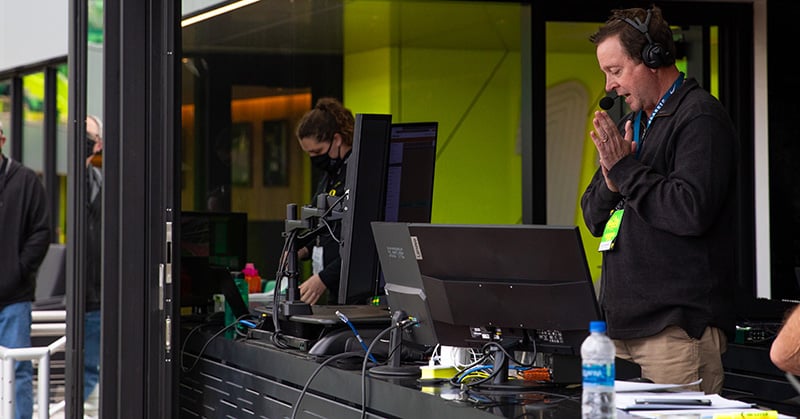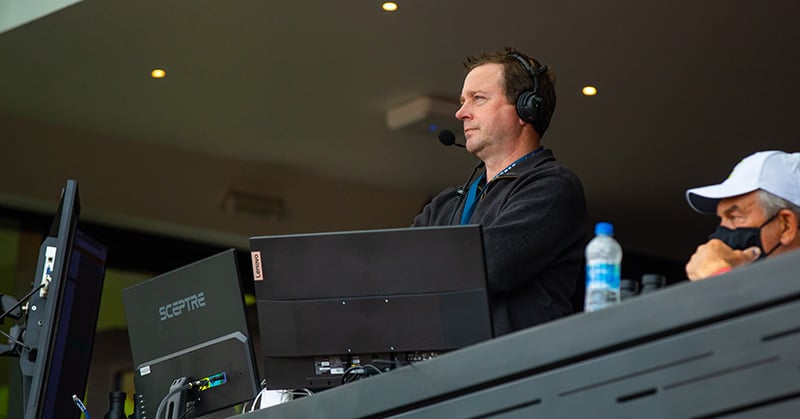
Paul Swangard, BA ’90 (radio and television), MBA ’99 (general business) grew up Eugene, and the influence of Tracktown USA on his life is undeniable.
As a child in the 1970s, “track was kind of like daycare for my parents,” he said. “They just dropped us off and they knew the meet would last several hours… we would be contained by the confines of Hayward.”
With many of the Nike’s early employees based in Eugene, Swangard saw the running community grow throughout his childhood. “It’s hard not to dream of stepping on the track and being a part of the whole thing,” he said.
As a South Eugene High School runner, Swangard was offered an opportunity to pursue his dreams as a sprinter at the University of Oregon. While his athletic career didn’t pan out as he hoped, he excelled in the classroom, became involved in local radio and television, and also enjoyed being a part of the Chi Psi fraternity on campus.
After earning his bachelor’s degree he worked as a sports director and reporter at KEZI for 10 years before returning to the UO to earn his master’s degree. After a brief stint at Intel as a senior product marketing engineer, he returned to the UO yet again and never left. From 2001–15 he was the managing director of the Warsaw Sports Marketing Center, running the sports business education program; and since 2016 he has been an instructor in the School of Journalism and Communications, where he teaches undergraduate and graduate courses in sports brand strategy and advertising.
In 1993, while working at KEZI, Swangard began announcing track meets at Hayward Field. In 2008 he announced men and women’s hammer throw at the US Olympic Trials, gaining additional experience.
“Slowly, I built a body of work,” he said.
Navigating a track meet for most fans means heavily relying on the guidance from the announcer from event to event, as several happen at once. This means Swangard is the ringmaster of the show.

“In most cases there are three, maybe four or five events going on at the same time,” said Swangard, who helps direct the attention of the crowd so they do not miss a performance, “to help drive energy to the long jump runway, where an athlete wants the attention of the crowd in between a lapse of the 5000-meter” and to then give crowd immediate context about what they just witnessed. From Olympic standards to personal bests to team points, Swangard helps fill in information about the athletes giving their all on the track.
The beauty of Hayward field is that it is designed for athletes, and Swangard is no exception—he creates an experience that is special to every athlete who has the chance to compete at Hayward Field. He shared, “One of the things that we’re trying to make happen in this first year is that we want to introduce every athlete formally in the stadium. [This is] something that sort of makes a moment for an athlete who gets to compete at Hayward Field in the inaugural year… I don't think you could say that there’s another venue in the world that would have that goal of introducing every athlete, but I think because the building was built for the athlete, that’s something that we’ve been trying to incorporate into our planning for each of these events.”
This is no easy task, as athletes from around the world have already competed at Hayward this spring. Swangard’s process includes preparing every detail, “down to finding every name and every pronunciation. It becomes a little bit of a labor of love to pull all that off.” If he comes across a name that is difficult on meet day, Swangard remembers the advice of his former colleague Scott Davis: “Just say their name like [they’re] your best friend.”
In any given track meet there will be 30-35 events happening. Swangard researches behind the scenes to stay up-to-date with statistics and the athletes who are competing. Being able to tell the audience if an athlete has qualified for the Olympic Trials, for example, is going to draw a lot of attention to that event.
“We’re so much closer to the action, we have more space to do our work” Swangard said of his area in the reimagined Hayward Field.
The latest technologies used in Hayward Field have created an opportunity to improve the experience for every fan. “We now have the ability to track every jump and throw in real time, through our computer and timing system,” Swangard said. “When I started, it was clipboards and radios, and it was just really clunky. So, as we get more efficient in a very data-driven sport, we’re now afforded more of a chance to be able to do that storytelling and give the fans some tools as well. So they can follow along with their handheld device.” Now, each attempt in the field events are being recorded. This optimizes the watching abilities for events that may not be in constant focus.
Swangard is well immersed in the world of track and field, and has been deeply involved in international meets including his work at the Beijing, London, and Rio Olympic Games. Whereas Swangard was the English language in-stadium announcer five years ago in Rio, this summer he’ll be returning to his television roots and will be calling the field events for NBC.

In addition to voicing meets across the world, Swangard also serves as chief strategist of track and field statistics sites athletic.net and runner space. These sites provide statistics and meet broadcasts for fans across the US and Canada. He is also the president of Bowerman Curve Collective Inc, a strategic consulting and media services firm.
The fan base in tracktown USA is like no other, there are not many college meets where fans know track like they do in Eugene. With this knowledge, fans know to follow Paul’s voice from the pole-vault pit to the shotput ring and across to the 100-meter start line. The fans are a necessary ingredient in the Hayward magic, and having that energy back will play a large role in meets moving into next season.
“When I’m not at Hayward Field and I announce at an Olympic Games or another major event, the crowd is just different,” said Swangard. “It’s not as educated, they don’t have the same rhythm to the way they react to things. I can always rely on the UO crowd to fill the void.
“Some of the greatest moments I’ve been part of at the stadium I’m not sure anyone could hear what I was saying on the microphone. That’s the beauty of Hayward Field. I have a role to play, the athletes have a much more important role to play, but the fans are what will bring the energy and the Hayward Magic.”
- Riley Ovall, UOAA associate. Images courtesy UO Athletics.